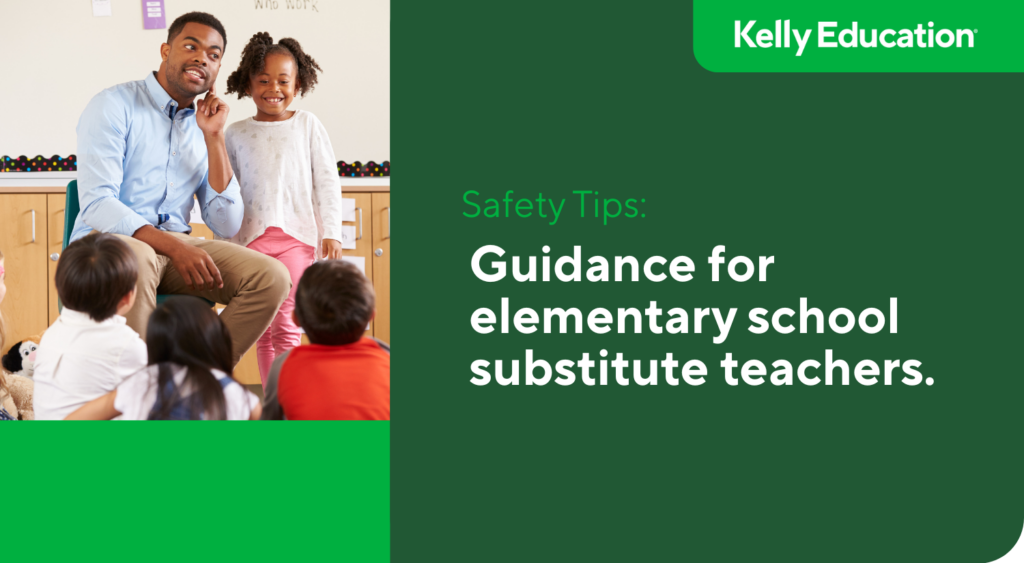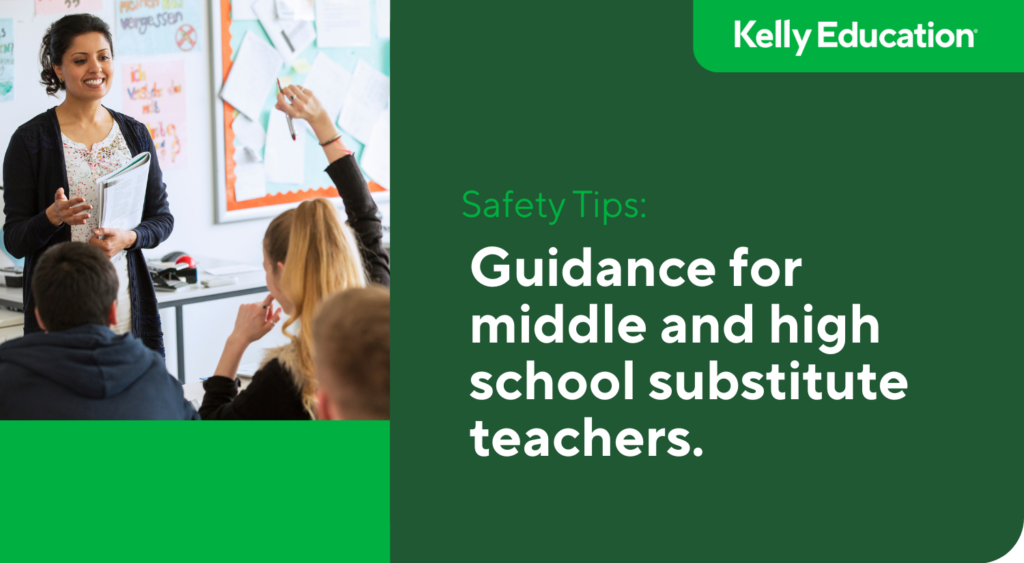Substitute teacher tips: Understanding IEP and 504 plans.

As a substitute teacher, you will have the opportunity to work with students with special needs in your classrooms. These students may have physical, learning, or behavioral disabilities. You will need to be familiar with and adhere to the students’ Individualized Education Program (IEP) or 504 plans.
This article will help you understand the basics of those plans and provide guidance to be an effective substitute teacher with every student, regardless of their learning path.
Special Education law.
To effectively educate and support students with special learning or behavioral needs, it’s important to understand the laws that protect students’ educational rights. The Individuals with Disabilities Education Act (IDEA) is a law designed to protect students with disabilities who require individually designed supports and services to assess their Free Appropriate Public Education.
If an IEP or 504 Plan is not followed with fidelity, there are legal proceedings that can take place. Parents have the right to employ advocacy services or request a due process hearing if they believe the rights of their children have been denied in any way. This is why it’s crucial for substitute teachers to understand IEP and 504 plans.
Individualized Education Program (IEP)
When a student is referred for an evaluation for qualification for specially designed supports and services in a school, the evaluation team must determine whether the child has a diagnosed disability. Then, they determine if that disability significantly impacts the student’s access to their Free Appropriate Public Education. Lastly, the team must determine if the student requires individually designed supports and services in order to have this opportunity. This develops into the IEP. Note that a student doesn’t need to come to the IEP team with a disability already diagnosed.
- The IEP contains learning goals and objectives and may contain other supports and resources for the student.
- These supports may include safety plans, behavior plans, speech therapy services, special transportation, or special personnel assigned to work with the student.
- The IEP protects every student’s right to receive a Free and Appropriate Education (FAPE) in the Least Restrictive Environment (LRE) available to meet the student’s learning and behavioral needs.
Section 504 of the Rehabilitation Act
The 504 law also protects the rights of those with disabilities. This law prohibits discrimination against students with disabilities, even if those disabilities are temporary.
Sometimes students with disabilities need accommodations to help remove barriers to learning based on their disability. For example:
- Separate seating to avoid distractions
- Allowing students to leave class early to avoid crowded hallways during transitions
- Offering extended time to complete assignments
- Providing access to a school nurse or other special support personnel
Americans with Disabilities Act (ADA)
The last law that impacts educators of students with disabilities is the broadest. The Americans with Disabilities Act (ADA) ensures that all person’s civil liberties are protected against discrimination. This, of course, includes students attending school.
How do I ensure I follow the law?
As a substitute teacher, you need to be aware that these laws exist. Your school district or employment agency should share this information during onboarding. It’s also important to have regular refresher courses or professional development reminders.
When you accept a job, ask the school principal or administrator for any documentation for students in your classes with IEPs or 504 plans. Keep in mind that these plans can only be discussed with those directly involved in carrying out a student’s educational program.
Often, the regular teacher will leave notes in a special folder for a substitute teacher. This information should tell you who has an IEP or 504 plan. It should also include which personnel at the school are responsible for helping you carry out programming for the student. Some key components of an IEP or 504 plan that are critical for every substitute teacher to know are:
- Accommodations and modifications for assigned work
- Specific goals the student is working on during the year
- Specialized personnel and support services
- Plans for safety or behavior modification
Following a student’s plan with integrity ensures the student receives what they need to be successful in class. It also helps you better manage the classroom. For example, if a student with a disability is allowed to take his test in a separate classroom with a support person, not following this accommodation could cause a negative result for the student or even the class.
Most importantly, though, you want to be the substitute teacher who provides an equitable education for every student who crosses your path. That is the true spirit of following a student’s specialized learning plan.
Educational settings.
Students with disabilities must be educated in the Least Restrictive Environment (LRE), designed to meet their needs. There are several educational settings that can be offered for students with disabilities. You could be asked to substitute teach in any of these settings. Here’s a brief description of the different types of school settings:
General Education: You may be asked to substitute teach in a general education class as the general education teacher. However, some students in your class will have IEPs or 504 plans. Even if a special education teacher or paraprofessional attends class to support students with plans, it is your job as the classroom teacher to maintain awareness of each student’s plan and ensure the plan is followed.
Special Education Inclusion Teacher: You may be called to substitute as an inclusion teacher. In this instance, you will likely stay with the class as a whole and co-teach in elementary school or be assigned to a specific subject matter or teacher to co-teach in middle or high school. Here you’ll teach every student in class, only intervening with students with IEPs and 504 plans when the lesson or situation requires the implementation of their plan.
Special Education Resource Teacher: You could also be called to substitute in a resource teacher’s classroom. In this setting, students with special learning or behavioral needs come into the smaller classroom environment for lessons. Students could be coming and going throughout the day for their particular support needs.
Special Education Self-Contained Teacher: In this setting, you would be called to substitute as the self-contained teacher, who has students for most of the school day in one classroom. These students typically have more significant disabilities and require more direct instruction and one-on-one or small-group instruction.
Strategies and suggestions.
Working with students with disabilities can be intimidating if you have not had this type of experience. However, it can also be one of the most rewarding experiences you will ever have. To see the look in a student’s eyes when they finally understand after struggling with a concept is a wonderful feeling for a teacher.
As a substitute teacher, always use these simple strategies:
- Establish rapport with students: Students can tell if you authentically care about them. Be warm and personable.
- Establish firm rules and boundaries: When students know the line, they feel a sense of security, safety, and respect.
- Be patient and allow extra time. Some students require extended time to answer questions and follow directions.
- Be flexible: Prepare to present the material differently or assess the student’s understanding of the material in non-traditional ways.
- Present material to meet various learning styles. For example, visual picture schedules can be a game changer for students with communication needs or developmental disabilities like Autism.
- Avoid power struggles with students: Just like students without disabilities, students with disabilities may react negatively to personnel changes. Stay calm, positive, and non-argumentative.
- Rely on colleagues for advice and support: Know your limits: if you feel you need more specific advice or support, contact the principal, nurse, or counselor for ideas.
You can do it.
Walking into a classroom of new student faces can be intimidating for anyone. This feeling may be more intense knowing there are students with disabilities present, but remember they are children, they are not their disability.
As a substitute teacher, you may not even know which students in a classroom have a disability and who do not, but that’s okay. Remember to focus on what strategies are best for all students, and know that you are providing the most positive experience for all students while you are there.
Grow as a substitute teacher at Kelly Education.
At Kelly Education, we want you to be successful, so we’ve assembled a library of articles and webinars that offer substitute teacher job advice so you can confidently lead your class. Here are just a few examples:
- substitute teaching tips for special education classes
- substitute teacher dress codes
- how to introduce yourself to the class
Not a substitute teacher yet? Fill out our brief interest form. One of our recruiters will contact you to answer your questions and share more about opportunities to become a sub teacher or paraprofessional with one of our school district partners.
View Related: Article Workplace culture
You might like
Find your next job
Discover thousands of temporary, full-time, and remote jobs for beginning and experienced job seekers.



